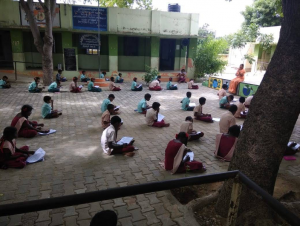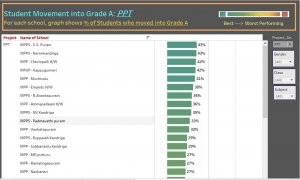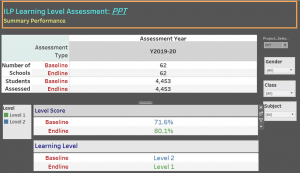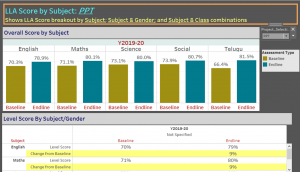Previous Articles related to ILP’s Monitoring and Evaluation System: (1) An introduction; (2) Attendance Monitoring
Sameera from Kawa village, Bihar studied Biological Science in her grade 8 middle school class this year. How much did her learning levels improve?
Answering this question requires us to delve deeper on several fronts:
- Coupling seamlessly with Govt. school processes
- Defining the scope of data collected
- Defining the granularity of data collected
- Evaluating answer sheets at scale; digitisation and visualisation of results
- Sharing results with the key stakeholders
We hope to give you a better understanding of the entire process by shining a big light on how we plan and execute our Learning Level Assessments (LLAs).
Coupling seamlessly with Govt. school processes
A Learning Level Assessment that is conducted in a Govt. school is an additional undertaking beyond their usual activities. ILP and our partner NGOs plan for several weeks to coordinate with each school principal to get their permission to organize these assessments. In addition to the school principals, we also strive for teacher participation. Many teachers work with us to design the question papers, conduct these additional assessments, evaluate the results, and analyze the final outcomes. The outcomes serve as feedback for improvement areas for each child, and to the overall program. ILP is currently conducting one assessment per year in many schools, and two per year (our goal) in an increasing number of schools.
Defining the scope of data collected
ILP’s mission is to enable children in government schools to attain grade appropriate skills. We assess students comprehensively across several subjects covered in the curriculum – Science, Social Studies, Math, Local Language and English. The scope of an LLA becomes exponentially larger for every additional subject and grade that we include in the assessment process.

Caption: Learning Level Assessment in progress
Defining the granularity of data collected
Granularity of data is another key aspect that adds complexity to the process. The table below shows some of the data granularity attributes, and the choices that we have made at ILP.
| Data Granularity | What ILP is doing |
| Student vs School | We collect data at the student level. We provide student-level data back to the schools and the community. We digitize and visualize the data in our dashboards at the school level. This is due to the significant effort required to digitize the student-level results. However, we are piloting student-level digitization / visualization in some of our projects |
| Geography | We aggregate data up to village, panchayat, taluk, district and state |
| Gender | We collect gender-level data. However, we allow for some project-unique circumstances where our teams may find it challenging to collect gender-level data |
| Grade Level | We collect data at the grade level |
| Subject vs. Within-Subject | We collect/analyze data at a subject level (example: Science). We are currently exploring how to collect a more detailed within-subject data in a scalable manner (example: Biology) |
Evaluating answer sheets at scale; digitisation and visualisation of results
Paper is still used as the primary means to conduct the LLAs in the schools – especially in the rural and remote villages that we work in. So, when thousands of students submit their answer sheets, ILP team members, with the help of teachers, meticulously evaluate the answer sheets and score them. Additionally, they digitize the results into spreadsheets, which feed our data analysis and visualizations. We have developed several visualizations to show us how the schools are performing.



Caption: Some examples of ILP’s LLA Dashboard visualizations
Sharing results with key stakeholders
The most important aspect of conducting LLAs is to share the results with our stakeholders. Teachers and parents are our primary stakeholders. Since every teacher, parent and village is different, our teams adapt the feedback to the needs of the local situation. This triggers meaningful discussions between teachers and parents to improve children’s learning levels.
At ILP, we recognize the importance of metrics. They provide our supporters a clear snapshot of the improvements we are pursuing. They help us measure our progress as an organization and identify areas for improvement and growth. Most importantly, they give us valuable insight into the performance of the students and schools that we support. We are continuing our efforts to make our entire process more efficient and more detailed to enhance our decision making.